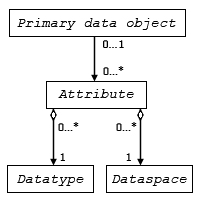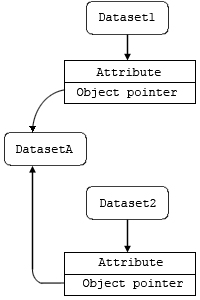
An HDF5 attribute is a small meta data object describing the nature and/or intended usage of a primary data object, which may be a dataset, group, or named datatype.
Attributes are assumed to be very small as data objects go, so storing them as standard HDF5 datasets would be quite inefficient. HDF5 attributes are therefore managed through a special attributes interface, H5A, which is designed to easily attach attributes to primary data objects as small datasets containing metadata information and to minimize storage requirements
Consider, as examples of the simplest case, a set of laboratory readings taken under known temperature and pressure conditions of 18.0 degrees celsius and 0.5 atmospheres, respectively. The temperature and pressure could be stored as attributes of the dataset could be described as the following name/value pairs:
temp=18.0 pressure=0.5
While HDF5 attributes are not standard HDF5 datasets, they have much in common:
| Note |
| Attributes are small datasets but not separate objects; they are contained within the object header of a primary data object. As such, attributes are opened, read, or written only with H5A functions. |
This chapter discusses or lists the following:
In the following discussions, attributes are generally attached to datasets. Attributes attached to other primary data objects, i.e., groups or named datatypes, are handled in exactly the same manner.
 |
| Figure 2: UML model for an HDF5 attribute and its associated dataspace and datatype. |
Creating an attribute is similar to creating a dataset. To create an attribute, the application must specify the object to which the attribute is attached, the datatype and dataspace of the attribute data, and the attribute creation property list.
The following steps are required to create and write and an HDF5 attribute:
The following steps are required to open and read/write an existing attribute. Since HDF5 attributes allow no partial I/O, you need specify only the attribute and the attribute's memory datatype to read it:
|
C Function
|
Purpose |
|
|
Creates a dataset as an attribute of another group, dataset, or named datatype. |
|
|
Writes an attribute. |
|
|
Reads an attribute. |
|
|
Opens an attribute specified by its name. |
|
|
Opens the attribute specified by its index. |
|
|
Closes the specified attribute. |
|
|
Calls a user’s function for each attribute attached to a data object. |
|
|
Deletes an attribute. |
|
|
Gets an attribute name. |
|
|
Gets a copy of the dataspace for an attribute. |
|
|
Gets an attribute datatype. |
|
|
Determines the number of attributes attached to a data object. |
An attribute has two parts:
An attribute's name is a null-terminated ASCII character string. Each attribute attached to an object has a unique name.
The value portion of the attribute contains one or more data elements of the same datatype.
HDF5 attributes have all the characteristics of HDF5 datasets except that there is no partial I/O capability; attributes can be written and read only in full, with no subsetting.
If attributes are used at all in an HDF5 file,
these three functions will be employed.
H5Acreate and H5Awrite are used together
to place the attribute in the file.
If an attribute is to be used and it is not currently in memory,
H5Aread generally comes into play,
usually in concert with one each of the
H5Aget_* and H5Aopen_* functions.
H5Acreate:
hid_t H5Acreate (hid_t loc_id,
const char *name,
hid_t type_id,
hid_t space_id,
hid_t create_plist)
loc_id identifies the object to which the attribute is to be attached, a dataset, group, or named datatype. This object, incidentally, is known as the primary data object; the attribute is a meta data object. name, type_id, space_id, and create_plist convey, respectively, the attribute's name, datatype, dataspace, and attribute creation property list. The attribute's name must be locally unique, i.e., it must be unique within the context of the object to which it is attached.
H5Acreate creates the attribute in memory;
the attribute does not exist in the file until H5Awrite
writes it there.
(Note that the attribute property list is currently unused. The only accepted value for create_plist is H5P_DEFAULT.)
H5Awrite or H5Aread, respectively:
herr_t H5Awrite (hid_t attr_id,
hid_t mem_type_id,
const void *buf)
herr_t H5Aread (hid_t attr_id,
hid_t mem_type_id,
void *buf)
attri_id identifies the attribute while mem_type_id identifies the in-memory datatype of the attribute data.
H5Awrite writes the attribute data, i.e., the meta data,
from the buffer buf to the file;
H5Aread reads attribute data from the file into
buf.
The HDF5 library converts the meta data between the in-memory datatype, mem_type_id, and the in-file datatype, defined when the attribute was created, without user intervention.
When accessing attributes, they can be identified by name or by an index value. The use of an index value makes it possible to iterate through all of the attributes associated with a given object.
H5Aopen_name:
hid_t H5Aopen_name (hid_t loc_id,
const char *name)
H5Aopen_name returns an attribute identifier that
can then be used by any function that must access an attribute,
such as H5Aread.
Use the function H5Aget_name, described below,
to determine an attribute's name.
The information required to establish an index
H5Aopen_idx:
hid_t H5Aopen_idx (hid_t loc_id,
unsigned index)
To determine an attribute index value when it is not already known,
you must first use the function H5Aget_num_attrs,
described below, to determine the number of attributes attached to
the primary object. The index values of the attributes attached to
that object range from 0 through 1 less than the value returned by
H5Aget_num_attrs.
H5Aopen_idx is generally used in the course of
opening several attributes for later access.
Use H5Aiterate, described below, if the intent is to
perform the same operation on every attribute attached to an object.
In the course of working with HDF5 attributes, one may need to obtain any of several pieces of information:
ssize_t H5Aget_name (hid_t attr_id,
size_t buf_size,
char *buf)
As with other attribut functions, attri_id identifies the attribute. buf is the buffer to which the attribute's name will be read; buf_size defines the size of that buffer.
If the length of the attribute name, and hence the value required for
buf_size, is unknown, a first call to
H5Aget_name will return that size. If the value of
buf_size used in that first call is too small,
the name will simply be truncated in buf.
A second H5Aget_name call can then be used to retrieve the
name in an appropriately-sized buffer.
H5Aget_space or
H5Aget_type, respectively:
hid_t H5Aget_space (hid_t attr_id)
hid_t H5Aget_type (hid_t attr_id)
H5Aget_space returns the dataspace identifier
for the attribute attr_id.
H5Aget_type returns the datatype identifier
for the attribute attr_id.
H5Aget_num_attrs:
int H5Aget_num_attrs (hid_t loc_id)
H5Aget_num_attrs returns the of number attributes
attached to the object identified by the object identifier
loc_id.
A call to H5Aget_num_attrs is generally the preferred
first step in determining attribute index values.
If the call to H5Aget_num_attrs returns
N, the attributes attached to
the object loc_id have index values
of 0 through N-1
It is sometimes useful to be able to perform the identical operation across all of the objects attached to an object. At the simplest level, you might just want to open each attribute; at a higher level, you might wish to perform a rather complex operation on each attribute as you iterate across the set.
H5Aiterate:
herr_t H5Aiterate (hid_t loc_id,
unsigned *index,
H5A_operator_t op_func,
void *op_data)
H5Aiterate successively marches across all of the
attributes attached to the object specified in
loc_id, performing the operation(s)
specified in op_func with the data
specified in op_data on each attribute.
When H5Aiterate is called,
index contains the index of the attribute
to be accessed in this call;
when H5Aiterate returns, index
will contain the index of the next attribute.
If the returned index is the null pointer,
then all attributes have been processed and the iterative process
is complete.
op_func is a user-defined operation
that adheres to the H5A_operator_t prototype.
This prototype and certain requirements imposed on the operator's
behavior are described in the H5Aiterate entry
in the HDF5 Reference Manual.
op_data is also user-defined to meet the requirements of op_func. Beyond providing a parameter with which to pass this data, HDF5 provides no tools for its management and imposes no restrictions.
Once an attribute has outlived its usefulness or, for whatever reason, is no longer appropriate, it may become necessary to delete it.
H5Adelete:
herr_t H5Adelete (hid_t loc_id,
const char *name)
H5Adelete removes the attribute
name from the group, dataset, or
named datatype specified in loc_id.
H5Adelete must not be called if there are
any open attribute identifiers on the object
loc_id. Such a call can cause
the internal attribute indexes to change; future writes to
an open attribute would then produce unintended results.
As is the case with all HDF5 objects, once access to an attribute
it is no longer needed, that attribute must be closed.
It is best practice to close it as soon as practicable;
it is mandatory that it be closed prior to the H5close
call closing the HDF5 library.
H5Aclose:
herr_t H5Aclose (hid_t attr_id)
H5Aclose closes the specified attribute by terminating
access to its identifier, attr_id.
Further use of attr_id is illegal; any function employing it will fail.
 |
| Figure 3: A large or shared HDF5 attribute and its associated dataset(s). DatasetA is an attribute of Dataset1 that may have been too large to store as an attribute. It is associated with Dataset1 by means of an object reference pointer attached as an attribute to Dataset1. Such an attribute can be shared among multiple datasets by means of addtional object reference pointers attached to addtional datasets. |
How small is small and how large is large are not defined by the library; it is left to the user's interpretation. (In considering attributes and size, the HDF5 development team has considered attributes to be up to 16K, but this has never been set as a design or implementation limit.)
\0.